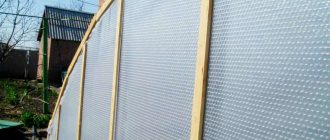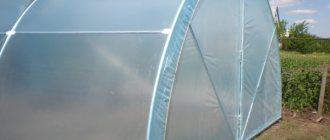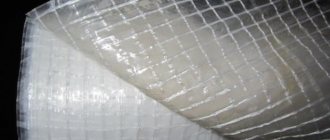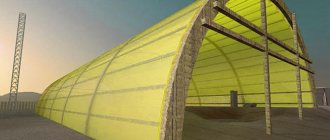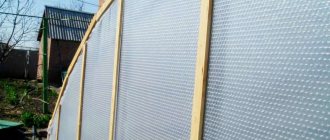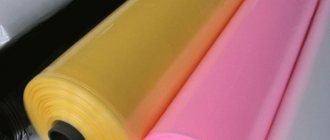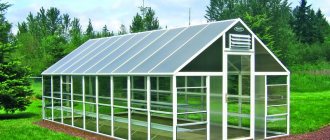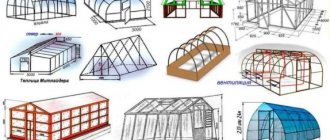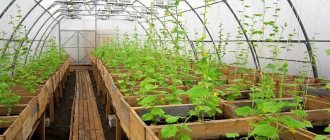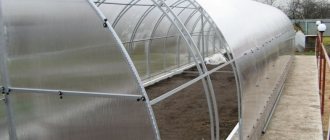A worthy alternative to conventional polyethylene film as a covering for greenhouses is reinforced film. This material retains the properties of conventional films, while having increased resistance to mechanical stress and tearing, and reliably protects against strong winds, hail, heavy snowfalls and low temperatures.
Reinforced film for greenhouses
What is reinforced film
Essentially, reinforced film is a multilayer material. It consists of two sheets of polyethylene film, fused onto a mesh frame on both sides. During operation, mechanical loads are placed on the mesh, due to which the fabric acquires high tensile and tear strength. The reinforced film remains vulnerable to punctures, but the area of damage is limited by the size of the cell and is easily restored.
Reinforced film
Tarpaulin awning: positive and negative reviews
The versatility of tarpaulin awnings contributed to the emergence of a significant number of reviews. Quality, cost, appearance are assessed. As for the price, everyone has the right to choose. Almost everyone evaluates the appearance as visually pleasing and aesthetically pleasing. There are different opinions on quality issues.
Sergey Serenky, Maykop.
“From the point of view of water-repellent properties, such an awning is not bad. If fixed well, no dirt will penetrate. But I’ll argue about strength. It doesn't tear, but it's easy to make a hole. I accidentally, without even applying any force, made a hole in the awning with a spatula. Of course, the defect was quickly eliminated and a patch was applied, but the fact of damage remains.”
Tarpaulin is characterized by high tensile strength and absolute inextensibility.
Andrey, Volgograd.
“It seems like the eyelets are holding on to nothing. On the first trip, two escaped. And most importantly, they cannot be replaced with the same ones; larger ones are needed. And I’ve never even met anyone like that. There is nothing to replace it with, I’m starting to get used to the holes. Maybe someone can tell me where to look?”
Oleg Steiko, Perm.
“An excellent awning, light, durable, I use it myself, and I give it to everyone who asks. I chose dense, 180 microns. I was looking for the eyelets not to be made of plastic, but metal. Two of them have already been lost. The problem is small, it covers everything with the same quality, it holds up well, but, probably, there was a defect when installing these rings. I even thought about returning the goods.”
Poorly inserted eyelets are a problem that occurs quite often in reviews. The majority of opinions are positive.
The folded tarpaulin product is distinguished by its compactness and does not take up much space.
Evgeny Simonenko, Yekaterinburg.
“Lightweight, I alone can cope with dimensions of 5x8 m. I’ve been using it for six months, there are no defects anywhere yet. I heard that you need to keep it in the sun less, I take it off and fold it when I don’t need it.”
Elena Postnikova, Yelets.
“When they made such a thin roof over my unfinished house, I was skeptical. But the builders were confident in the correctness of their actions, and I just watched silently. Moreover, they connected blue awnings together, making one out of two, ring into ring. At first, I ran to check after every rain. These torpoulin awnings even withstood snow. Now I joke that I want to live under this blue sky.
There are few conflicting reviews about tarpaulin. As a disadvantage, weak eyelets dominate. Users highlight lightness, variety of sizes, price and reliability of protection from precipitation as advantages.
Types of reinforced film
There are several modifications of reinforced films. The main differences are in the material of the outer layers and the mesh frame.
Types of reinforced film
The latter can be made with different cell sizes, and the following are used as threads for weaving:
- fiberglass;
- lavsan;
- high pressure polyethylene;
- polypropylene.
The carcass threads have different thicknesses, which affects the weight and strength of the material.
Cell size also affects film performance. The larger the cells, the higher the light transmission of the material, which is very important for providing comfortable conditions for plants. And the strength of the coating improves with decreasing cells.
The smaller the cells, the higher the strength characteristics of the film
The optimal size, providing excellent light transmission and increased strength, is 15x15 mm.
Reinforced film cell size
Film Alkorplan 3000, Byzance Blue 1.65 m
The outer and inner layers differ in material, density, thickness and the presence of additives that improve consumer properties.
The following additives are used for greenhouse films:
- transforming light (allowing ultraviolet rays to pass through and infrared radiation to be blocked);
- hydrophilic - their use prevents condensation from collecting in drops and falling on the plants, the water simply rolls down the walls;
Advantage of hydrophilic film
- antistatic (with their help, dust and dirt particles are repelled from the surface of the material);
- heat-protective;
- light-stabilizing - they help slow down the process of destruction of the material under the influence of sunlight, increasing the service life of the material.
Reinforced film for construction
There are also special “breathable” reinforced films. A microscopic ventilation hole is made in each cell of such material, which ensures free access of air to the plants.
For reference. For greenhouses covered with “breathable” film, there is no need to make vents. The process of caring for plants becomes much simpler and easier.
Greenhouses covered with breathable film do not need windows
Films are produced in three classes - economy, standard and premium. The price is directly dependent on the quality.
They produce films that are transparent and painted in various colors. For greenhouses, it is preferable to use transparent ones, although colored ones are also acceptable.
Green reinforced polyethylene film, 6x4 m
Prices for reinforced PVC film
PVC reinforced film
Tarpaulin construction awnings: unlimited use
The main qualities of this covering material make it possible to use it for various industrial, commercial and domestic purposes.
Tarpaulin has different densities. Minimum – 50 g/m². Sugar bags are made from this fabric. For the manufacture of awnings, tarpaulin is used, the density of which is 65 g/m² and higher.
The elasticity of the material allows you to cover objects of various configurations. The awning can be installed on the frame - an excellent temporary shelter will appear. If you connect several awnings, you get a large canvas, with which you can set up a temporary large storage room. Tarpaulin canopies in construction are often used to create canopies, as well as to protect cargo materials during transportation.
Due to its elasticity, tarpaulin can be used to cover construction objects of various configurations.
On a note! As a canvas for covering building materials, you should not choose tarpaulin with a density of less than 120 g/m². Friction against a hard surface is inevitable in this case, and this can significantly reduce the service life of the awning.
The edges of tarpaulin awnings are always additionally reinforced with polypropylene tape soldered inside. Eyelets are inserted into the dense part of the awning (along the edge) at a distance of 1 m from each other. The extreme, corner eyelets, which bear the maximum load, have additional plastic inserts.
Construction tents can have very different sizes. For small parameters, fabric of low density is most often used. For example, a 2x3 m construction awning is made from a material whose density is 65-100 g/m². Usually produced without eyelets and has a budget price. This is a popular option for shelter for a short period of time. In addition to its direct purpose, the awning can be used at home, during camping trips, fishing, where it will serve as a tent or canopy.
Tarpaulin awnings have low cost, light weight and durable structure, and they can be used at temperatures from -40 ° C to +80 ° C.
With dimensions of 4x5 m, the construction awning already has eyelets and is made of denser fabric (from 75 g/m² and above). Although there are also economical options with thin fabric. For large canvas sizes (100 m² or more), reinforced film is used, the density of which starts from 170 g/m².
Release form
The film comes out of the conveyor in rolls of various widths and lengths. Standard roll sizes are shown in the table.
Reinforced film is available in rolls
Table. Standard sizes of reinforced film for greenhouses.
| Density g/m2 | Width, m | Length, m |
| 140 | 2, 3, 4, 6 | 10, 25, 50 |
| 200 | 2, 3, 4, 6 | 10, 25, 50 |
| 250 | 2, 3 | 10, 25, 50 |
| 300 | To order | To order |
For reference. When purchasing, read the certificate of conformity for the product and read the storage conditions. Do not purchase rolls with damaged packaging - the canvas inside may be damaged.
For ease of transportation, wide webs are folded into several layers before winding - three-meter sheets in half (the roll has a height of 1.5 m), and six-meter sheets - in three layers (the roll has a height of 2 m).
Types of polyethylene film
To improve the performance characteristics of the popular material, improved versions of traditional film have been developed. Special properties are acquired if special components are added during production: light stabilizers, heat stabilizers, antistatic and hydrophobic additives, anti-blocking and sliding components, phosphors.
Depending on the purpose, operating conditions, and the specifics of the plants being grown, you can choose the most suitable option.
This type of film is produced in rolls up to 20 m, the width of the canvas is 2-6 m, the color is matte white, blue, green, transparent. A yellowish tint indicates a manufacturing defect or improper storage.
Reinforced film has a number of advantages:
- durability – up to 6 years of year-round operation;
- durable, wear-resistant;
- easily repaired if individual cells are damaged;
- not damaged by ultraviolet radiation.
Disadvantages include high price, reduced light transmission, and tendency to become dirty.
Advantages and disadvantages of reinforced film
In terms of basic indicators, reinforced films are superior to conventional polyethylene films. The main arguments that manufacturers give in their favor are strength and durability. Indeed, reinforced fabric can withstand strong winds, hail and heavy rains, maintaining its characteristics. Resists tensile strength very well. If, nevertheless, the integrity is broken under the influence of mechanical loads, then the place of rupture does not spread over the entire area, but is contained by a reinforcing mesh. The damage can be easily repaired with tape or a patch.
Reinforced film 180g/m2 (25m) Rendell
Special additives in the composition of polyethylene greatly increase the value of reinforced film. They extend the service life of the greenhouse coating to 6-8 years, protect plants from ultraviolet radiation, and provide good heat conservation. Ease of installation is another significant advantage of the material.
Summary table of characteristics of different types of film
Disadvantages include reduced strength compared to glass or polycarbonate and a higher price compared to conventional film. For a permanent greenhouse, designed for many years of service, reinforced film is not used, but for temporary structures it is perfect.
For reference. There are films suitable for year-round use and films that must be removed for the winter. Be sure to check when purchasing what type of material you choose.
Color matters
The color of the film indicates its beneficial characteristics and helps plants absorb the most favorable spectrum of solar radiation. Color additives are spectrum mixers:
- lightproof black mulching - covering film for greenhouses;
- blue and blue film for greenhouses has good anti-condensation properties and is destroyed in the ground within 4 months;
- pink three-layer – translucent and durable, service life about 6 years;
- black and white protects plants from being burned by the sun's rays.
The heat-retaining characteristics of the material depend on the additives and vary in color
The choice of film and size for it depends primarily on the size of the greenhouse and the material for the frame: metal or boards
Israeli multilayer film 6 meters long is quite durable. By covering the greenhouse with two layers, you don’t have to worry about temperature fluctuations outside the greenhouse. The film can be of different colors.
Many people prefer to choose high-quality polyethylene film with a width of 6 meters, since it can last for many years
Film color:
- Blue;
- White;
- Yellow;
- Black;
- Transparent.
The inflatable greenhouse is very popular. It is quite durable, easy to install and use
Manufacturers
The distribution network offers films from Russian and imported manufacturers for sale. For comparison, here are brief characteristics of some production companies and the films they produce.
Zagorsk Experimental Plastics Plant
Films produced in Zagorsk are distinguished by their quality and durability. The threads of the frame layer are made of LDPE monofilament. The film itself is elastic, stabilized against the damaging effects of light, durable and suitable for the construction of greenhouses. ZZZP has launched the production of large-format canvases (up to a width of 6 m). To protect its products from counterfeiting, the company uses special marking of fabrics with red thread.
Reinforced film "ZZP"
Table. Types of markings for two-meter wide films.
| Thickness | Manufacturer's marking |
| Film 120 microns | 3 red threads in the center |
| Film 140 microns | 2 red threads in the center |
| Film 160 microns | 1 red thread along the edge |
| Film 200 microns | 1 red thread in the center |
An interesting special greenhouse film “Red Cell”, which is very elastic and durable, protects plants from ultraviolet rays.
Reinforced greenhouse film from ZZP
LLC TD "Novopolymer"
The company's production workshops are located in Chekhov, Moscow region, the main office is in Moscow, and the branch is in Novosibirsk. They produce reinforced film under the STREN brand, which has already found its admirers.
LLC "TD NOVOPOLYMER"
The reinforcing frame is made of high-strength polypropylene, and the laminating layers include complex additives for resistance to external factors, increasing light transmittance, and mechanical strength. STREN film is capable of operating in the temperature range from -50 to +80°C. A distinctive feature of STRAEN film is the increased size of the mesh cells to 15x15 mm, which further reduces the weight of the film and expands the access of light. What you need for greenhouse coverings.
Reinforced three-layer film STREN (STREN)
Film made in China – “Economy”
Three-layer polyethylene fabric with reinforcing polyethylene mesh. Light-stabilizing additives are not used in production, so the film is used only for temporary structures - outdoors it becomes unusable within just one season. The only advantage of this canvas is its low cost.
Reinforced film "Economy 120"
Leno reinforced film
Production has been launched in Korea and China. The reinforcing mesh is made of polyethylene, the outer layers are also polyethylene (both with and without additives). There is a range of canvases with different technical characteristics. In terms of price and quality, they are somewhat lower than their Russian counterparts, but are in good demand.
Reinforced film Leno - Korea, China
Films from Western manufacturers are of high quality, but their cost is much higher. Therefore, Russians prefer domestic films, which are also more adapted to our climatic conditions.
Reinforced film TENAX Net Film
Manufacturing technology of tarpaulin fabric
Relatively recently, a new type of covering material has appeared - tarpaulin. The word "tarpaulin" is translated from English as "tarpaulin". It is made of polyethylene. The production process is reminiscent of fabric manufacturing technology. The threads are intertwined, but not natural, but from fused polypropylene. The threads form a dense base, which is laminated on both sides with opaque polyethylene. The result is a material that is in many ways superior in performance characteristics to tarpaulin and polyethylene used for covering. This is an imported material; it is produced in Turkey, China, Korea, Poland and other countries. The price of tarpaulin is significantly lower than the cost of domestic covering materials.
The fabric has a pleasant blue or green color and has a number of high quality characteristics:
- lightweight, much lighter than tarpaulin;
- hydro- and vapor-tight;
- tear-resistant;
- elastic;
- UV resistant;
- has low cost.
The raw material for the production of tarpaulin is polyethylene, its elongated strips are tightly intertwined and then laminated on both sides.
Initially, tarpaulin was used during road works. But almost immediately the scope of its application expanded significantly: awnings began to be made from the fabric. Today there is no worthy alternative or competition for this covering material.
Where are reinforced polyethylene films used?
Reinforced fabrics are used not only in the construction of greenhouses and greenhouses. They have proven themselves excellent in hydro- and vapor barrier of roofs and walls of buildings, fencing for various purposes, and construction of canopies. In agriculture, reinforced film sheets help protect silage pits, stored dry feed, etc.
Reinforced film awning
Arched greenhouse in film
Thermal washer for polycarbonate
In this article you will find everything you need to know about the types, characteristics and application of thermal washer for polycarbonate! We also recommend reading the article on how to make a greenhouse from window frames with your own hands.
Recommendations for the selection and installation of reinforced film during the construction of greenhouses
The choice of covering material depends not only on the required functionality, but also on the size and design of the structure. If you first purchased the material and then begin construction, then when designing the greenhouse frame, take into account the width of the reinforced film sheet. The fewer cutting lines, the easier and faster the finished greenhouse will be made.
For reference. Choose a film with optimal technical characteristics suitable specifically for your climate. This will save you a decent amount.
Stage 1. First of all, the frame of the building is made, on which a film is then applied. The frame itself can be made of wood, metal, plastic pipes. All edges of the structure that will come into contact with the film must be carefully aligned and painted white or covered with insulating material.
Wooden frame for greenhouse
Stage 2. The canvas should not be cut in advance - it is much more convenient to try it on in place, and then, leaving the necessary allowance on each side, cut it and fix it on the prepared base.
Stage 3. When attaching the canvas to wooden blocks, use nails or self-tapping screws, which are nailed and screwed through special wooden slats. The method is not entirely reliable, but it is accessible and therefore often used. Fastening the canvas with a special stapler is very similar. Plastic packing tape is suitable as a spacer. With the correct size of brackets, the fastening is reliable and durable, and installation takes very little time.
Fastening reinforced film to wooden blocks. For many, this is the worst way to cover a greenhouse, because you have to damage the film. Such film does not last long, at most a couple of seasons
It is convenient to use a construction stapler for work
If in the first method the film is attached to the frame of the greenhouse both on the sides and to the roof rafters, in this method the film is attached only to the ends of the greenhouse
Alternatively, you can cut a tape from old linoleum or any other strong material
For fastening to plastic pipes or special fittings, it is good to use plastic clamps produced for this purpose. If you don’t have them, make them yourself from pipes of larger diameter - it’s not difficult. The greenhouse frame made of galvanized profile requires special fastenings that come with the profile.
Fastening the film using special plastic clips
You can secure the film to the greenhouse using special clips
The simplest way to secure the covering material is to stretch a strong cord or elastic band over the fabric. They will press the canvas to the frame of the building, but the reliability of such fastening is low - you will have to constantly monitor the greenhouse and tighten sagging canvases. It is permissible to use it only for a short period in the expectation that you will have to thoroughly work on the permanent fastening of the canvas to the frame of the structure. If you have time, it is preferable to immediately choose a more reliable option.
Film fixation system for greenhouses. This fixation system consists of 2 parts - a PVC clip (UV-resistant) and a galvanized (aluminum) profile. The principle of its operation is clear - PVC snaps into the profile together with the film without any damage to the material
The safest way to attach the film to the greenhouse. First, the greenhouse needs to be covered with film, and a mesh is attached over it. The mesh itself is tied to the body
Eyelets and elastic cord. Eyelets are holes in the film, reinforced with metal or plastic rings. The method is not suitable for ordinary film, only for strong film and preferably with the addition of a cuff that will prevent the eyelet from breaking through the material.
Reinforced polyethylene film is a material that is easy to use. The builder will not need complex professional skills - a person who knows how to work with his hands can easily build a home greenhouse from such a film.
Agrofibre with polymers
This coating contains polymer fibers. This film has the following advantages:
- Low cost of material.
- The lightness of the film, which does not require the creation of a powerful frame.
- It transmits the sun's rays well.
- Extremely easy to use. It is attached with clips to the frame, tied or stitched.
- The greenhouse under such material breathes and receives moisture.
Disadvantages: short service life - three years, plus very weak thermal insulation.
Which film to choose for a greenhouse is up to the farmer to decide. Modern manufacturers are constantly improving the quality of the material they produce, trying to combine several advantages in one product.
Based on the type of use, films for greenhouses are divided into perennial and multi-season. The difference between them is that the perennial greenhouse film is not removed for the winter, while the rest should be removed and taken to a room where the temperature does not drop below 15 degrees. For example, reinforced can be classified as perennial. Acrylic film is used for greenhouses.
To decide which film is needed for a greenhouse, it is important to calculate the cost and wear life of the material. It is also worth considering that lightweight polypropylene film does not require a powerful frame, but using it in cold climates is ineffective.
For growing heat-loving crops (for example, peppers and eggplants), a light coating is not suitable. In order not to risk being left without a harvest, you should pay attention to more expensive materials, but they will require reliable capital structures. In short, the choice is up to the farmer himself.
Greenhouses under film have many advantages. They are easy to disassemble when they need to be rearranged, are quite compact and do not require special installation costs.
The most popular types of film greenhouse are frame (“house”) and arched. Both plastic and metal pipes are suitable for making the frame.
Even large farms prefer to install light film greenhouses rather than stationary greenhouses.
